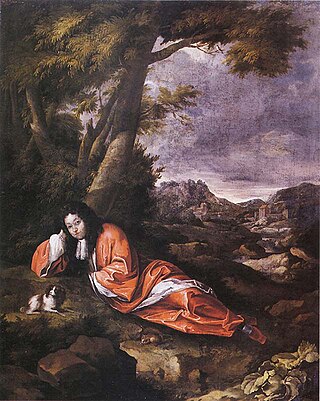Related Research Articles

The Battle of the Boyne took place in 1690 between the forces of the deposed King James II, and those of King William III who, with his wife Queen Mary II, had acceded to the Crowns of England and Scotland in 1689. The battle was fought across the River Boyne close to the town of Drogheda in the Kingdom of Ireland, modern-day Republic of Ireland, and resulted in a victory for William. This turned the tide in James's failed attempt to regain the British crown and ultimately aided in ensuring the continued Protestant ascendancy in Ireland.

Patrick Sarsfield, 1st Earl of Lucan was an Irish army officer. Killed at Landen in 1693 while serving in the French Royal Army, he is now best remembered as an Irish patriot and military hero.

The Treaty of Limerick, signed on 3 October 1691, ended the 1689 to 1691 Williamite War in Ireland, a conflict related to the 1688 to 1697 Nine Years' War. It consisted of two separate agreements, one with military terms of surrender, signed by commanders of a French expeditionary force and Irish Jacobites loyal to the exiled James II. Baron de Ginkell, leader of government forces in Ireland, signed on behalf of William III and his wife Mary II. It allowed Jacobite units to be transported to France, the diaspora known as the Flight of the Wild Geese.

The Williamite War in Ireland took place from March 1689 to October 1691. Fought by Jacobite supporters of James II and his successor, William III, it resulted in a Williamite victory. It is generally viewed as a related conflict of the 1688 to 1697 Nine Years' War.
The Battle of Newtownbutler took place near Enniskillen in County Fermanagh, Ireland, in 1689 and was part of the Williamite War in Ireland between the forces of William III and Mary II and those of King James II.
This is a list of people who have served as Lord Lieutenant of Louth.
Colonel James Porter (fl.1686–1701) was an Irish politician and supporter of the Catholic King James II.
Jeremiah O'Donovan, The O'Donovan of Clan Loughlin, Lord of Clan Loughlin, was MP for Baltimore, County Cork, Ireland, in James II's Patriot Parliament of 1689, alongside his kinsmen Daniel O'Donovan of Clancahill and Daniel O'Donovan.
Sir James Fitz Edmond Cotter was a soldier, a colonial governor and the commander-in-chief of King James's forces, in the Irish Counties of Cork, Limerick, Tipperary and Kerry. He was a prominent political figure in the south of Ireland and was of Royalist and Jacobite sympathies. He was also a member of the Irish Cotter family of Norse-Gaelic origins. He was born around 1630, the second son of Edmond Fitz Garrett Cotter of Anngrove and Elizabeth Connell of Barryscourt, was knighted in 1685–1686, and died in 1705.
Oliver O'Gara was an Irish politician and soldier of the 17th and 18th centuries who was closely identified with the Jacobite cause.
Henry Wharton was an English soldier known for his service in the Williamite War in Ireland, where he died in 1689. He was a distant relation of his namesake the writer Henry Wharton.
Dominick Sarsfield, 4th Viscount Sarsfield was an Irish aristocrat and supporter of the Jacobite cause during the Williamite War in Ireland.

John Bellew, 1st Baron Bellew of Duleek was an Irish Jacobite soldier and politician.
Sir Patrick Trant, known as Sir Patrick Trant, 1st Baronet between 1686 and 1691, was an Anglo-Irish politician and Jacobite.
Colonel Dudley Bagenal or Bagnall was an Irish soldier, Jacobite politician and courtier.
Roger Maguire, styled Lord Maguire of Enniskillen, was an Irish Jacobite soldier and courtier.
Thomas Bellingham was an Anglo-Irish soldier and politician.
Nicholas Browne, 2nd Viscount Kenmare was an Irish Jacobite politician and soldier.
Mark Baggot was an Irish Jacobite politician and soldier.
Henry Hamilton-Moore, 3rd Earl of Drogheda PC (Ire) was an Anglo-Irish peer and soldier.
References
- ↑ O'Sullivan, Harold (1992). "The Jacobite Ascendancy and Williamite Revolution and Confiscations in County Louth 1684-1701". Journal of the County Louth Archaeological and Historical Society. 22 (4): 432. doi:10.2307/27729726. JSTOR 27729726 . Retrieved 1 February 2023.
- ↑ Officers of the Jacobite Armies, Centre for Robert Burns Studies, University of Glasgow. Retrieved 1 February 2023.
- ↑ O'Hart, John, The Irish Parliament of King James the Second in 1689, Irish Pedigrees: or the Origin and Stem of the Irish Nation (5th Ed., 1892), Volume 2. Retrieved 1 February 2023.
- ↑ J. G. Simms, War and Politics in Ireland, 1649-1730 (A&C Black, 1 Jul 1986), p.162-3.
- ↑ O'Sullivan, Harold (1992). "The Jacobite Ascendancy and Williamite Revolution and Confiscations in County Louth 1684-1701". Journal of the County Louth Archaeological and Historical Society. 22 (4): 436. doi:10.2307/27729726. JSTOR 27729726 . Retrieved 1 February 2023.